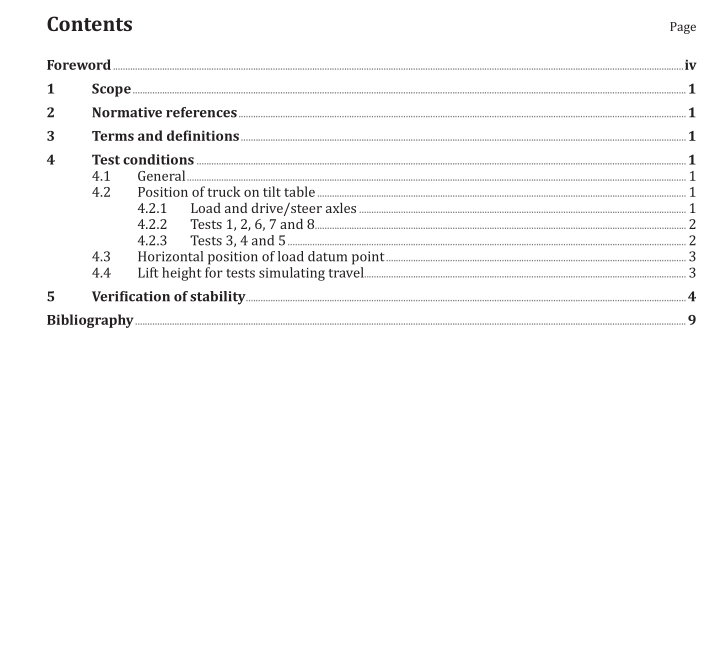ISO 22915-3:2021 pdf free download.Industrial trucks — Verification of stability — Part 3: Reach and straddle trucks
This document specifies the tests for verifying the stability of reach trucks (with retractable mast or fork arm carriage) and straddle trucks, equipped with tilting or non-tilting masts or fork arms and
having a rated capacity up to and including 5 000 kg. It is also applicable to such trucks operating under the same conditions when equipped with loadhandling attachments.
2 Normative references
The following documents are referred to in the text in such a way that some or all of their content constitutes requirements of this document. For dated references, only the edition cited applies. For undated references, the latest edition of the referenced document (including any amendments) applies.
ISO 5053-1, Industrial trucks — Vocabulary — Part 1: Types of industrial trucks
ISO 22915-1, Industrial trucks — Verification of stability — Part 1: General
3 Terms and definitions
For the purposes of this document, the terms and definitions given in ISO 5053-1 and ISO 22915-1 apply.
ISO and IEC maintain terminological databases for use in standardization at the following addresses:
— ISO Online browsing platform: available at https://www.iso.org/obp
— IEC Electropedia: available at http://www.electropedia.org/
4 Test conditions
4.1 General
See ISO 22915-1.
4.2 Position of truck on tilt table
4.2.1 Load and drive/steer axles
The load and drive/steer axles are shown in Figure 1.
4.2.2 Tests 1, 2, 6, 7 and 8 The truck shall be positioned on the tilt table so that its drive/steer axle, B–B, and load axle, C–C, are parallel to the tilt axis, X–Y, of the tilt table (see Table 1). 4.2.3 Tests 3, 4 and
5 The truck shall be positioned on the tilt table with the line, M–N, parallel to the tilt axis, X–Y, of the tilt table (see Table 1). Point M is defined as follows.
a) For trucks with a single non-articulating drive (steer) wheel: point M shall be the vertical projection onto the tilt table of the point of intersection between the centreline of the drive/steer axle and the centreline of the drive wheel width.
b) For trucks with a non-sprung castor wheel: 1) for tests carried out on the castor wheel side of the truck, point M shall be the vertical projection onto the tilt table of the point of intersection between the centreline of the castor wheel axle and the midpoint between the castor wheel or the two castor wheels, with the non-sprung castor being positioned with the centreline of the castor wheel axle nearer to the centre plane of the truck; 2) for tests carried out on the drive (steer) wheel side of the truck, point M shall be the vertical projection onto the tilt table of the point of intersection between the centreline of the drive/ steer axle and the centreline of the drive wheel width.
c) For trucks with a drive/steer axle in an articulating frame articulated in the centre plane of the truck: point M shall be the vertical projection onto the tilt table of the point of the intersection between the lateral axis of the articulating frame and the centre plane, A–A, of the truck.
d) For trucks with a sprung castor wheel and a single non-sprung drive (steer) wheel: point M shall be the vertical projection onto the tilt table of the point of intersection between the centreline of the drive wheel axle and the centreline of the drive wheel width, with the axle of the drive wheel positioned at right angles to the tilt axis.
e) For trucks with non-articulated dual drive (steer) wheels in pivoting mounting: point M shall be the vertical projection onto the tilt table of the point of intersection between the centreline of the drive axle and the centreline of the width of the drive wheel closer to the tilt axis, with the axle of the drive wheels positioned at right angles to the tilt axis.
f) For trucks with non-articulated, non-sprung chassis castors: point M shall be the vertical projection onto the tilt table of the point of intersection between the centreline of the castor wheel width, with the non-sprung castor positioned with the centreline of the castor wheel axle nearer to the centre plane of the truck.
g) For trucks with a non-articulated, single-drive wheel (steered) on the centre plane, A–A, and sprung castor wheels: point M shall be the vertical projection onto the tilt table of the point of intersection between the centreline of the drive wheel axle and the centreline of the drive wheel width, with the axle of the drive wheel positioned at right angles to the tilt axis. The castor wheel closest to the tilt axis shall be positioned at right angles to the tilt axis and the castor wheel axle shall be nearer to the centre plane of the truck.ISO 22915-3 pdf download.ISO 22915-3 pdf download
